
Butchering a deer
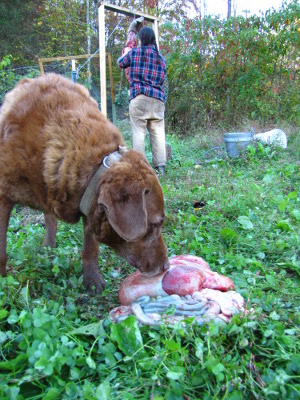 I
hate to admit it, but the biggest reason it's been two years since we
killed a deer is because of the butchering. In 2009, cutting up a
full-size deer was a daunting task and left a bit of a sour taste in my
mouth. Since then, I've become a pro at gutting and dressing
chickens and am no longer even mildly horrified by the task.
I
hate to admit it, but the biggest reason it's been two years since we
killed a deer is because of the butchering. In 2009, cutting up a
full-size deer was a daunting task and left a bit of a sour taste in my
mouth. Since then, I've become a pro at gutting and dressing
chickens and am no longer even mildly horrified by the task.
Add in an awesome meat
grinder that Rose Nell gave us (thank you!), and turning a deer into
freezer-ready packages of quality meat took only about two hours per
animal. That's two hours of me cutting and Mark fetching things
and taking pictures.
Now, I'm not saying that
I'm a master deer butcher, and I actually made most of the process up
as I went along. So I hope anyone who's cut up more than three
deer will leave a comment with some tips to make next time go even
smoother. Meanwhile, those of
you with weak stomachs should move along and I'll show everyone else
exactly what I did.
Step one was to remove
the entrails. All I needed was a good sharp knife to carefully
cut through the skin of the deer's belly without puncturing the
guts. Then I reached in the hole and yanked (and then poured)
everything out.
One of the deer had a
couple of small white spots on its liver, so I gave that to the
chickens to play it safe. I saved the other liver, and let Lucy
have the 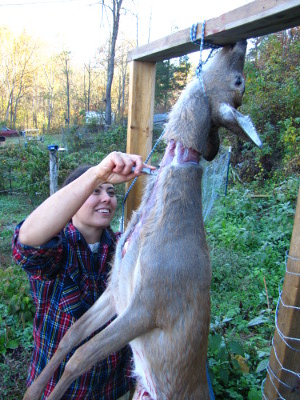 entrails.
entrails.
Question one for the
pros --- How do you deal with the last bit of intestine that attaches
to the anus? With chickens, I just cut out the whole vent, but
due to the structure of the deer's pelvis, I had to cut through the
intestine, giving the possibility of a tiny amount of fecal matter
contacting the meat. I'm sure there's a better way.
Next was the hardest
part --- skinning the deer. Next time, I'll probably make Mark do
this because skinning two deer in fast succession made my carpal tunnel
act up.
Except for needing a lot
of hand strength, though, skinning is pretty simple. We hung each
deer up in a chicken pasture gate frame (boy did those come in handy)
and slit through the skin in a circle around the neck.
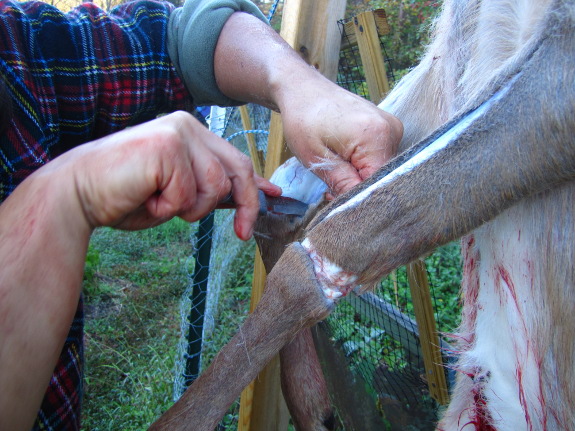
Next, I slit around and
up each foreleg. The bottom half of a deer's leg has no meat to
speak of, so I didn't skin that part.
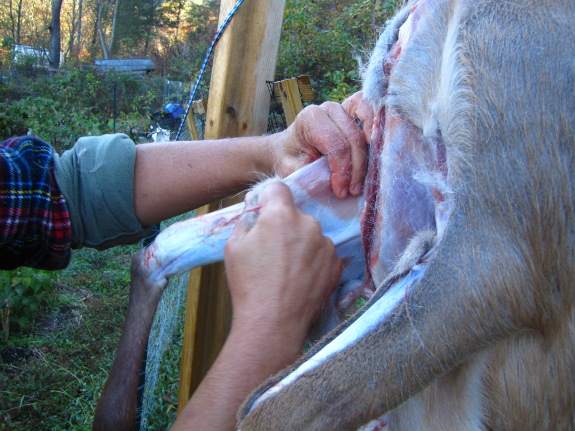
Now I pulled the skin
back off the forelegs. I used a knife now and then during the
skinning process, but mostly pulled instead of cut, since yanking does
a better job of keeping all the meat on the carcass.
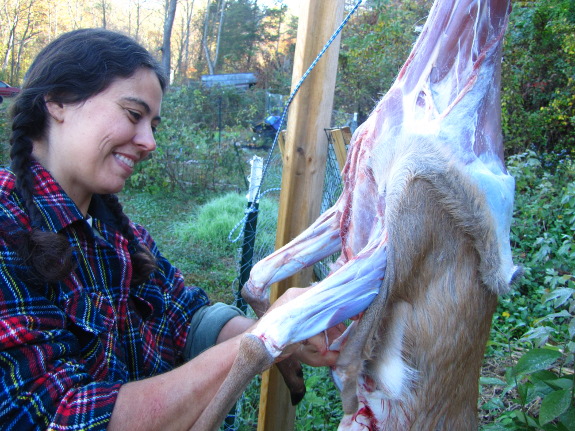
A slit from the legs up
the neck and then down to the gutting incision allowed me to start to
"undress" the deer.
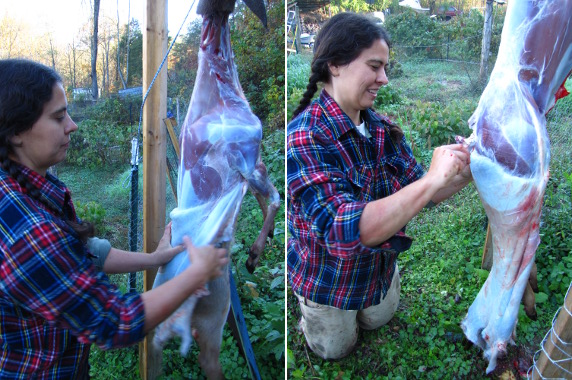
Yank, yank, yank!
Before long, it looked like my naked deer was wearing a skirt. I
cut off the tail, then pulled the skin right down to the deer's "knees"
(really, they're ankles, but they look like knees to us.)
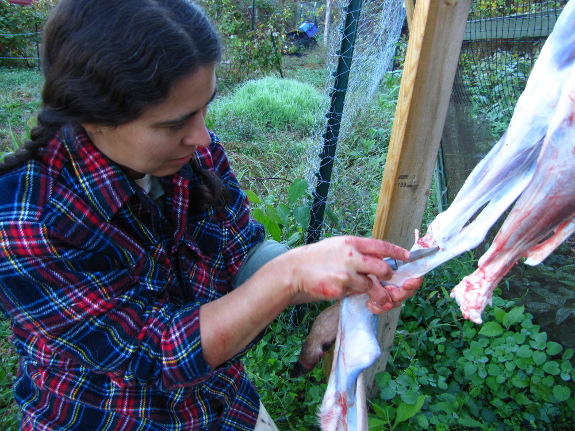
Here's where I had a bit
of trouble. My goal was to cut off the deer's lower legs (the
meatless parts), but I couldn't seem to find the right spot on the
joint to allow me to just cut lightly and bend to separate the two
bones. Is there a trick to this? I hacked at ligaments and
twisted a lot, eventually removing all four lower legs.
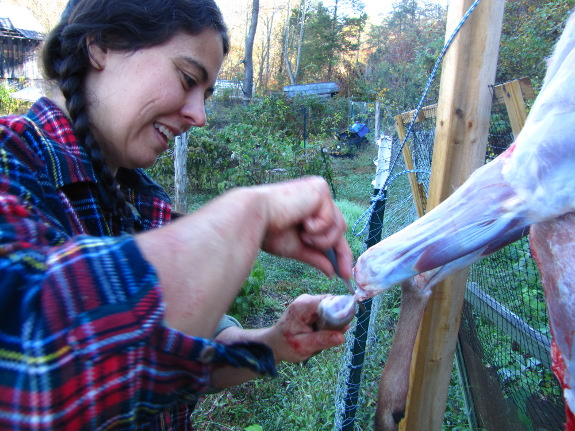
Here I am finally
getting one of the lower forelegs loose.
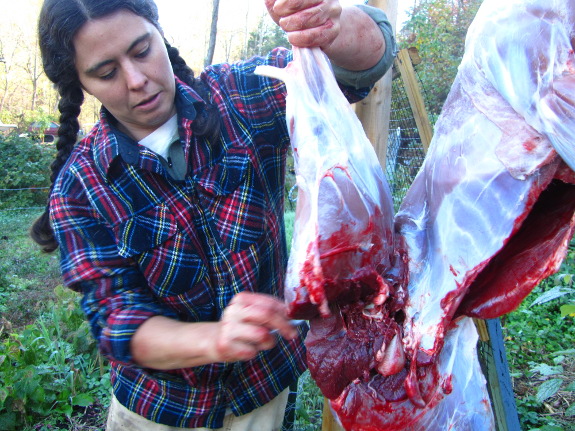
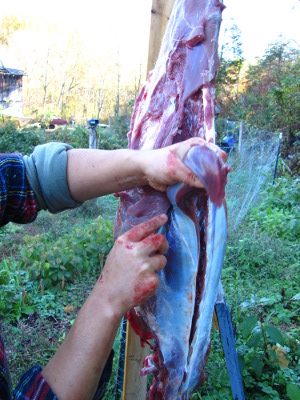 Old timers tend to let their
deer hang for a few days at this stage to age the meat, but it wasn't
really cold enough and we didn't have an animal-proof spot. So I
just cut it up and stored the meat in the fridge for a while to get the
same effect.
Old timers tend to let their
deer hang for a few days at this stage to age the meat, but it wasn't
really cold enough and we didn't have an animal-proof spot. So I
just cut it up and stored the meat in the fridge for a while to get the
same effect.
Cutting off the hams
(back legs) was easy --- just slit through the meat and twist until the
ball-and-socket joint comes loose. The front legs came off nearly
as simply.
Next came the tenderloin
(aka backstrap.) Some picky modern hunters consider this the only
part of the deer worth eating, and it's the part I save to make steaks
out of. The meat is above the ribcage, along the bony projections
above the spine.
Finally, I cut around
the neck and twisted the head off. I gave Lucy the latter and
brought the ribcage inside. After rinsing it well, I sliced off
any easy chunks of meat, then put the rest in a big pot of water to
simmer into the base of venison stew. Deer butchering complete!
| This post is part of our Venison lunchtime series.
Read all of the entries: |
Want more in-depth information? Browse through our books.
Or explore more posts by date or by subject.
About us: Anna Hess and Mark Hamilton spent over a decade living self-sufficiently in the mountains of Virginia before moving north to start over from scratch in the foothills of Ohio. They've experimented with permaculture, no-till gardening, trailersteading, home-based microbusinesses and much more, writing about their adventures in both blogs and books.
Want to be notified when new comments are posted on this page? Click on the RSS button after you add a comment to subscribe to the comment feed, or simply check the box beside "email replies to me" while writing your comment.

But I have butchered a few deer. Unfortunately I don't have a good tip for you on joints other than I keep several extremely sharp knives on hand and keep changing them out as I go.
As for the anus and pelvis, I approach the deer from the other direction than you do. I hang the deer with it's head down and it's rear ankles are put in one of those metal thingies they call a gambrel, Mark could probably make you one with some welding of spare parts. I start with the anus, cutting delicately around it then pinch it off with one hand. Some people zip tie it or string tie it shut at this point, I've never tried that. Then I use a meat saw to delicately divide the pelvis. If you can find a meat saw that is narrow enough, or a gerber multitool it is best to start from the inside and saw outwards. Although you can spend some time sawing from the outside if you're careful just to reduce the amount of bone to saw through.
Then I start the slice up the belly letting the guts spill out as I do so. When you get to the end of the slice you'll have to reach up into the rib cage and sever the esophagus. Then I move onto the skinning, like you do. Some of my friends take a small torch to the deer after skinning to get rid of any hairs that remain on the meat. I also don't age my meat in the open air as I tend to catch my deer early in the season when it's not safe to hang the meat.
Thanks for the anus and pelvis tips! I'm going to have to digest that for a while (and probably reread it before our next deer) but I suspect it'll be very helpful.
I had read that most people butcher the deer the other way, which makes more sense with your anus tip.
Probably good to have the trophy hunting tip on the post for others, but I don't think we'll be mounting deer heads anytime soon.
When I read this I was very impressed with what you two accomplished! The more you practice and do it the more it comes to you and the faster you get. The fact that your the ones doing it rather than taking it to a locker is a good thing...alot of "hunters" just take it to the locker and dont have the connection to the meat, so good job!
As for tips....this might sounds out there and crazy, but we dont actually ever gut our deer when we do them. My dad had a butcher show him how to "bone out" a deer with the most meat per time used. Usually we are doing this in the woods freshly after a kill and approach the downed deer. The meat is put into trash compactor bags since they are more durable, which is inside an old army metal frame backpack to haul out of the woods when completed. Since we've begun saving the hides to tan, we start by lying the deer on their back and making a cut up the inside of both hind legs. Then basically skin the leg and using a 5" filet knife we take as much meat off the leg as possible. After you've had practice you had usually get a couple huge primal cuts like hams off it, with plenty of smaller odds and ends. Also it allows you to get to the hip ball and socket joint to remove the entire leg bones with simple cuts. Repeat the same procedure on the other hide leg. The front legs are done very similar, except that instead of a ball and socket joint you can take the entire shoulder off with your knife by cutting the meat and soft tissue. Then remove as much meat as you desire and now you've got a limbless deer. What we've started to do is slowly and carefully split the hide up the inside, careful to not cut into the guts, then slowly peel the hide back towards the backbone. This allows access to the backstraps while keeping hair to ground and avoiding ground to meat exposure as much as possible. Once youve taken all the meat off the one side you want, simply roll the carcass over and repeat, except that now your taking the hide completely off when your done.
We do it this way for a couple reasons that work for us. 1) It leaves the carcass, bones, entrails, and "trash" in the woods for the coyotes and other game to get at the remains...which helps them out and also leads to more opportunities for us when coyote season and fur season are on. 2) By leaving the guts inside, it limits the chance of exposure to the meat. It also lets the meat go right into the compactor bags, which typically go right into a big freezer until we have time to work them into smaller freezer friendly portions. 3) Also by leaving the deer carcass there, you dont have to mess with hauling it out of the woods, then hauling the "trash" off after your done butchering.
But again, this works for us because we typically hunt on timber only land where a deer carcass can be left for the natural world to get at. It doesnt work for everyone and does take alot of practice, but works well for us. Simply slide the backpack on your back with your tag, and hike it back to your vehicle. Also, since ive gotten into knifemaking, ive seen some made with deer bone handles (jawbone for handle, the knob in the leg bone)...so we can tie those parts off so they dont get drug off and lost, let the critters do their thing and come back later in the year to retrieve to reuse.
As always, im always here to help if I can. Welcome to the world of venison harvest and keep up the good work. Now just convince Mark to tan the hides and your on your way to complete self sustained living!
DRESSING: I do it pretty much like Phreak said. I use a device called a "butt-out tool" from Walmart to remove the anus while on the ground. tie it off, then hang head down. I cut off all 4 legs at this point at the knees, then make incisions on the back of the rear legs above the knees and run a stick between the tendon & femur. After he/she is hung up I make the lateral cut and spill the organs out, cut the diaphragm out, and then saw through the breast bone with a hacksaw, remove the heart and lungs, etc.
SKINNING: This is The worst part of the whole ordeal for me, I suck at it. I make a Y cut on the thighs and work the skin as best as I can down, then the head and cut it off like you would a rabbit (I don't save trophies).
BUTCHERING: I usually do the front legs first, then the backstrap, then the rear hams. I'm no expert here either, since my uncle grinds the meat up I usually only fret over the backstrap. I usually shoot Does, so I don't bother with the neck but I've heard it makes decent hunk of stew meat, especially on from a larger buck. After I've got everything I want, I usually halve the carcass and let the dogs have at it.
David Z --- I was especially hoping you would comment --- thank you!
I like your method, but we use the bones and wouldn't want to "waste" them. First, we boil them to get all that extra meat off and make a soup base, then they head into Lucy's bowl. But maybe your method could be modified by taking most of the meat off before cutting into the entrails (if I did it quickly) so that there was less chance of contaminating the meat?
Phil --- Sounds like two votes for "butt-out". Thanks for the in depth discussion of your methods!
Kathleen and Josh --- We let Lucy drag off the hides this time. On the one hand, I'd like to learn to tan a hide sometime, but on the other hand, it's pretty daunting to add on one more new task when faced with that big of an animal! Maybe I'll read up on it for next time.
You mentioned the tenderloin (aka backstrap). They are actually two different things. What you cut were the backstraps. There are also smaller pieces, the tenderloins, near the spine on the inside of the ribcage that are accessible after dressing the deer.
Many hunters that I know (including myself) dress their deer in the woods as soon as they shoot them. This helps the deer cool off faster and makes for less 'gamey' taste. They age all of the meat (either by hanging in cool weather, or in the fridge as you did), except for the tenderloins. Those are usually on the grill before the end of the day, and ooooohhhhh sooooo tasty!
Great job on the two deer!! Here in Maine, we're only allowed a single deer per season (except for archery in some specific areas), and for me this year, it's a buck or nothing. Only a couple days left - hope I see one!
My friend from Montana, who literally grew up on venison, says that deer leather really isn't very good. This is a guy who lived in a family that ate meat when they shot a deer and they had heat when they cut and split wood. And he's not a thin guy. The cut roughly 18 cords of wood a year, not because they needed that much but because his mom was bipolar and would open the windows and let all the damn heat out.
So they killed their fair share of venison. I guess all I'm trying to say is that I trust his opinion when it comes to homesteading and he thinks tanning deer hide just isn't worth the time. No reason not to do it just for fun, but there are probably other chores that will yield a better harvest. Personally, ever since I watched my first western I've wanted a pair of deerskin britches, but as I've gotten older I've wondered how the hell you make those things smell good after you sweat on them for a day. Since I don't have a solution for it, I've moved my dream onto a huge fieldcoat made of many animals that would a) be cheap b) look cool c) be warm d) be far enough away from my skin for me to sweat on them.
We advertise for deer in our neck of the woods with a "deer wanted" sign during hunting season. We've been given up to 8 in a season so far (we'll take more than that).
We hang the deer from the hind legs with a gambrel connected to a chain hoist which allows us to adjust the height as we work. We start the skinning from inside the rear legs upward to the knees. Once the rear legs are skinned, we work downwards toward the head. We skin around the anus and pull the hide off of the tail. If need be, we cut the tail off with the hide. Much of the hide can be pulled off or forced free with a fist from the inside against the carcass. We slit the hide down the middle of the belly and along the inside of the front legs, skinning out the front legs up to the knee before progressing onto the neck. We extend the slit down the belly down the throat to the jaw. When we've got the skin all the way to the head, we cut the head and hide off. Then, it's time to get the entrails out.
We loosen things up around the pelvis and then slit downwards along the belly to the breast bone, being careful not to puncture anything with the knife and holding the stomach and intestines back so they don't fall out and get in the way. Once we're down to the breastbone, we let the insides come out, cutting them free from the backbone on the inside. We also strip any fecal matter down the large intestine away from the anus (just move your thumb and finger along the intestine). Once it's all moved sufficiently back in the intestine, we can cut the intestine in the pelvis area. This leaves a short section and the bladder to be removed later. Then, the diaphragm can be cut and the lungs, heart, and esophagus can be removed. Sometimes it helps to slit down to the esophagus along the throat and cut it loose first.
At this point, we cut the front legs off at the knew using a bone saw or hack saw (10 tpi blade). We cut below the knew which is faster than cutting the joint. We remove the front legs/shoulders (with a knife). We remove the neck, often cutting some with the saw if we don't get between the vertebra properly with the knife. Then, we cut the ribs off on either side near the backbone but away from the backstraps and tenderloins. We then remove the back just below the pelvis. We split the pelvis (combination knife and saw) which allows us to remove the bladder, anus, and remaining intestine piece. Then, we cut through the bone to separate the hind legs from one another. We take them off the gambrel and cut them with the saw just above the knew.
We store the pieces in a refrigerator until we are ready to cut all of the meat off of the bones in a day or two. This allows us to clean off sinew, fat, and membranes as we desire and to separate muscles from the rump for roasts. We also remove the tenderloins (a special treat) and slice the back straps into steaks after removing them. We cut off the rest of the meat for ground and cook down the bones for stock.
Another way to skin a deer (I've done this on a couple of goats and some sheep) is to use a vehicle. Slit the hide from chine to pelvis. Slit outwards from the belly along the inside of all four legs. Peal the hide back off of the front legs. Then, starting in front of the ears, cut the hide and begin pealing it back to the neck. Tie the deer around the neck to something stationary (attached to a limb up off the ground is good), and tie a stout cord around the hide behind the ears. Hook the other end of the cord to a vehicle (I hooked it to the front bumper of my truck) and then slowly pull it off. No knife marks on the hide, which is good for tanning purposes.
Skinning became the easiest part of the butchering process once I began removing the hide with mechanical help. I have used vehicles, golf carts, come-a-longs, tractors, etc. to pull the hides from the deer.
You can do this with the deer lying on the ground or hanging by the neck such as your photos. Slit the hide along the inside of all legs and along the belly from the anus to the neck. Cut a ring around the neck hide. Peel the hide from the neck and shoulders a slight bit. Find a rock about the size of a tennis ball. Put the rock inside the neck hide. This forms a "lump" that you can tie a rope or chain around. Tie the other end to your vehicle. Next tie the deers neck to something stationary. Slowly pull the vehicle away from the deer and the hide should peel right off.Congratulations on your deer and I hope this info helps.
phreak --- I've felt previously that tanning the hide wasn't worth it, so good to hear some firsthand data backing that up. On the other hand, I love to learn to do things, so if I only tan one hide so I'll know how it's done, that's probably worth it just for the mind candy.
I suspect that you don't wash leather clothes. Probably you wear long johns underneath in the winter (not sure about the summer) and wash those instead. That's how I treat my work pants, anyhow --- they only get washed every week or two because there's not much difference in their state of filthiness between day 1 and day 7.
Darryl --- Very helpful butchering advice! I like your simple method of stripping the fecal matter down so that you don't risk contamination when you make the cut. And it sounds like I shouldn't be worrying over those joints --- just cut the bone. I think your explanation has sounded the best so far.
Darryl and Jay --- I'd read about the vehicle method of skinning a deer, but our vehicles are often half a mile away from our house, so I figured it wasn't worth the hike. Maybe if we ever kill a deer when we've got vehicles handy... (I'll bet Mark's winch would do the job with ease.)
Maybe if we ever kill a deer when we've got vehicles handy... (I'll bet Mark's winch would do the job with ease.)